Deers
Best Shot Placement for Deer Hunting Success
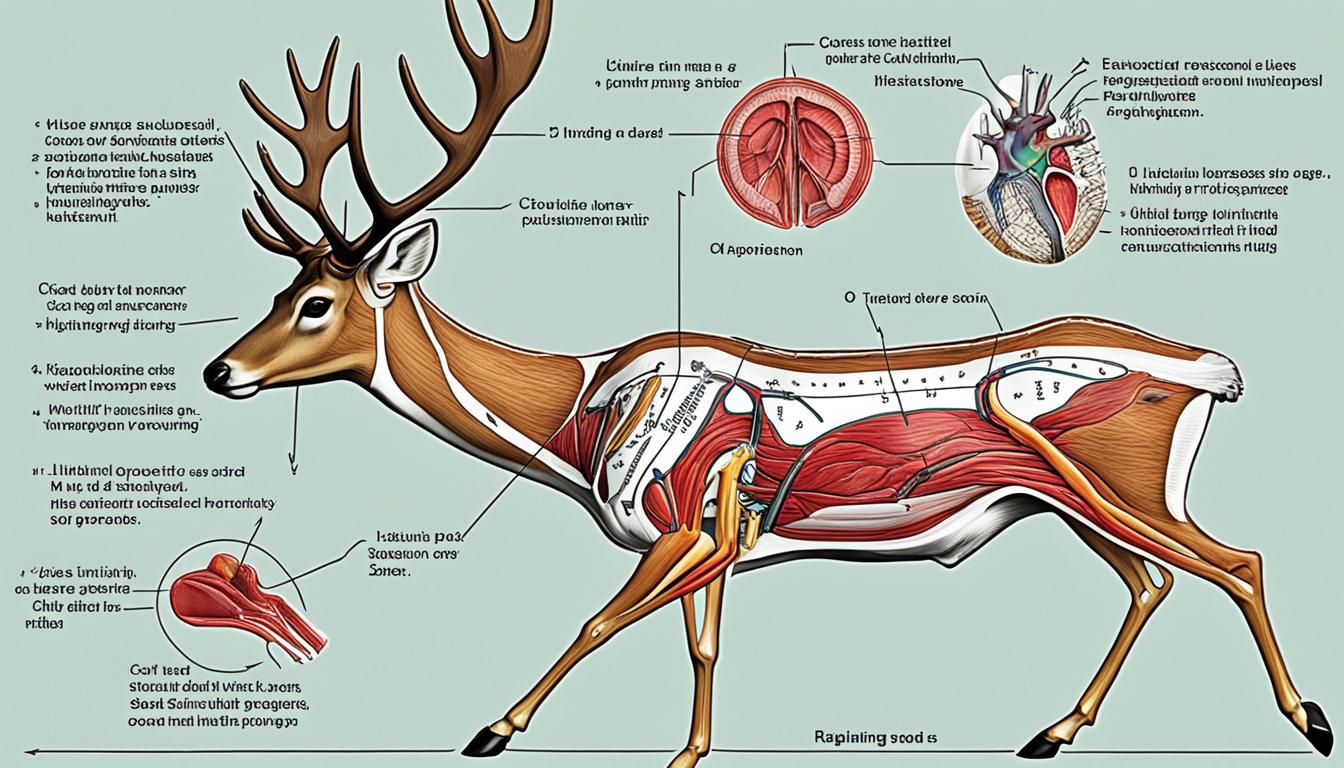
Every hunter knows that shot placement is key for a successful and ethical deer harvest. Having knowledge of deer anatomy and understanding where to aim from different angles can greatly improve your chances of a clean, ethical kill. Surprisingly, over 50% of hunters wound deer without recovering them due to inaccurate shot placement. This alarming fact underscores the significance of mastering shot placement techniques to guarantee a humane and responsible hunt. This detailed guide will explore the essential organs of a deer, the optimal shot placements for different angles, and the significance of precision in hunting.
Key Takeaways:
- Shot placement is essential for a successful and ethical deer harvest.
- Poor shot placement can result in wounding and lost deer.
- Understanding deer anatomy is crucial for accurate shot placement.
- The heart and lungs are the primary targets for a swift and clean kill.
- Mastering shot placement techniques ensures a responsible and humane hunt.
Deer Anatomy 101
To improve shot placement, it’s essential to have a good understanding of deer anatomy. The vital organs, such as the heart, lungs, and liver, are prime targets for ethical kills. The lungs, located behind the front shoulder, offer a larger target with a higher margin of error. The heart, partially covered by the lungs, is a smaller but equally important target. The liver, hidden behind the diaphragm, is smaller and more challenging to hit. By knowing the location of these vital organs and understanding the deer’s physical structure, you can make more accurate shots from any angle.
| Vital Organs | Location | Shot Difficulty |
|---|---|---|
| Lungs | Behind the front shoulder | Relatively easier |
| Heart | Partially covered by the lungs | Requires precision |
| Liver | Behind the diaphragm | More challenging |
Deer Vital Organs: Heart and Lungs
When it comes to deer hunting, targeting the heart and lungs is crucial for a quick and humane kill. A well-placed shot to the lungs results in rapid blood loss and organ failure, ensuring a swift and clean takedown. This shot placement technique is highly effective and forgiving, making it an excellent choice for less experienced hunters seeking a quick kill.
Another vital organ to target is the heart. While hitting the heart requires more precision and skill due to its smaller size and the potential movement of the deer, it can result in an equally swift and ethical kill. A heart shot also leads to rapid blood loss and organ failure, incapacitating the deer swiftly.
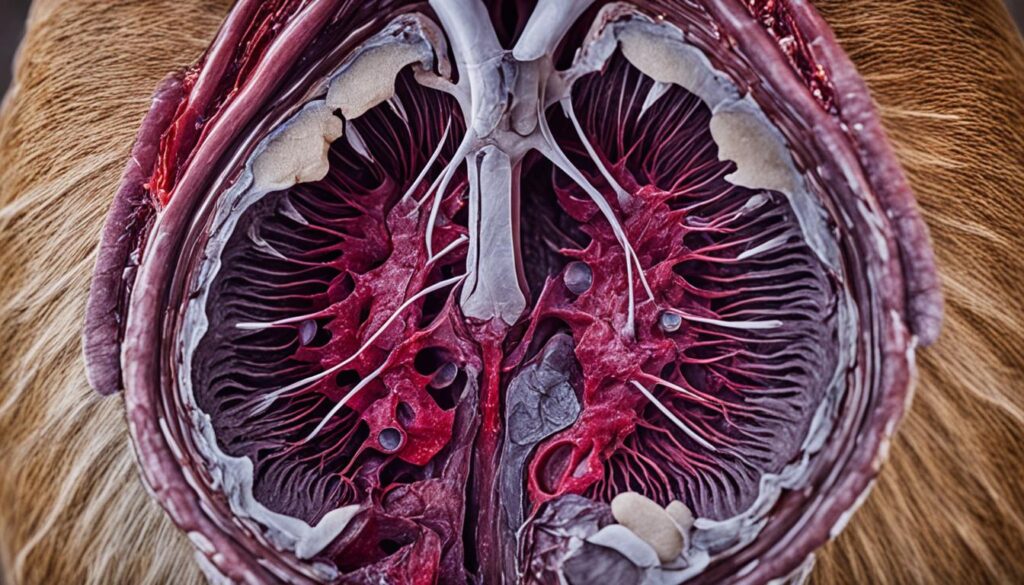
Both the lung shot and heart shot are reliable choices for ethical hunting, but they require different levels of accuracy. The lung shot provides a larger target area and allows for a higher margin of error, making it an ideal option for hunters who may not have mastered extreme precision. On the other hand, the heart shot demands more skill and control due to its smaller size and the need to compensate for potential deer movement.
Choosing between a lung shot and a heart shot depends on a hunter’s skill level and the specific circumstances of the shot. It’s essential to consider factors such as the distance, angle, and the deer’s behavior before deciding which target to aim for. Regardless of the chosen shot, hitting either the heart or lungs will result in a quick and ethical kill, minimizing suffering for the animal.
Tissue, Muscle, and Bones in the Deer’s Body
Deer possess a formidable defense system composed of muscles, bones, and tissue that serve to protect their vital organs. Understanding the anatomy of these organs and the tough structures surrounding them is essential for achieving successful shot placement during hunting.
Protective Shoulders and Scapula
The shoulder and scapula play a crucial role in providing power for a deer’s movement. However, their positioning also makes them challenging targets. Achieving precise shot placement in this area demands skill and accuracy to avoid wounding the animal instead of making a clean kill.
The High-Stakes Shot: The Spine
The spine presents hunters with a high-risk, high-reward shot opportunity. A well-placed shot targeting the spine offers an instant takedown, rendering the deer immobile. However, due to the small target area and the potential for erratic movement, tremendous accuracy is required to make this shot a success.
Targeting the Rib Cage: The Kill Zone
The rib cage, encompassing the heart and lungs, is considered the optimal kill zone. Understanding the position of the rib cage provides hunters with a clear target area for achieving a clean kill. Precise shot placement within this region ensures swift organ damage, leading to a quick and ethical takedown with minimal suffering.
| Target Area | Importance |
|---|---|
| Rib Cage | The sweet spot for a clean kill, housing the vital heart and lungs. |
| Shoulder and Scapula | Challenging targets that require precision shooting skills. |
| Spine | A high-stakes shot offering an instant takedown but demanding unparalleled accuracy. |
Understanding the structural barriers protecting the vital organs is essential for successful shot placement during deer hunting. By being knowledgeable about the shoulder and scapula, spine, rib cage, and the corresponding kill zones, hunters can enhance their accuracy and increase the probability of a swift and ethical kill.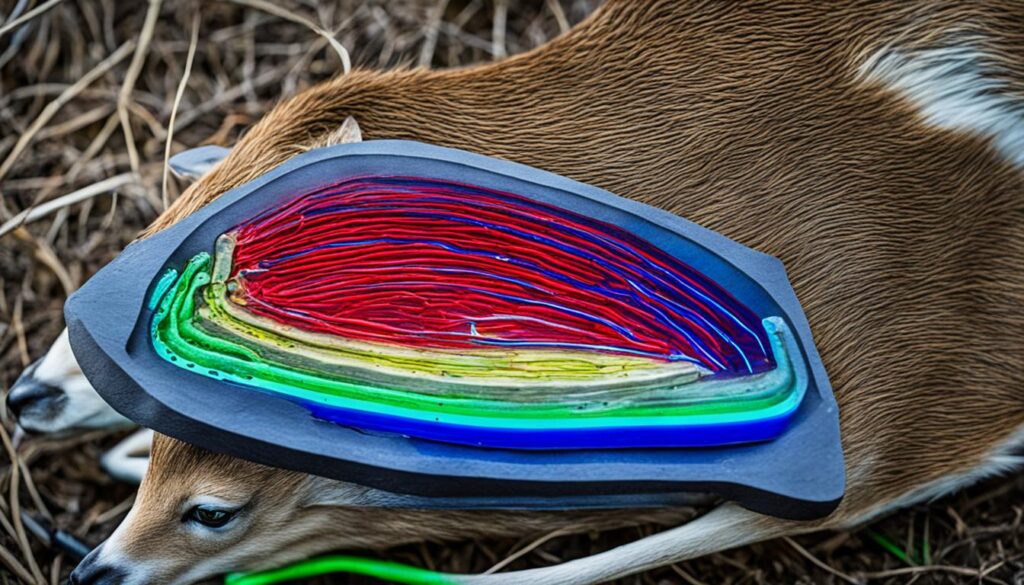
What’s the Best Shot Placement on Deer?
The best shot placement on a deer is targeting the lungs. Due to their larger size and proximity to the heart, the lungs offer the most substantial kill zone and safety net. A clean shot to this area causes rapid blood loss and organ failure, resulting in a quick and efficient kill. While hitting the heart and lungs is a deadly combination, it requires more precision. The lungs remain the optimal target for a clean and ethical takedown.
When hunting deer, understanding the best shot placement is vital for achieving a quick and ethical kill. By focusing on the lungs, hunters can increase their chances of success while minimizing unnecessary suffering for the animal.
“Targeting the lungs provides a larger margin of error and ensures a humane, ethical kill,” says seasoned hunter and wildlife expert, John Anderson. “Hitting this vital organ leads to rapid blood loss and subsequent organ failure, resulting in a clean and effective takedown.”
While the heart and lungs present a deadly combination, it’s important to note that hitting the heart requires more precision due to its smaller size and potential movement of the deer. The lungs, on the other hand, offer a larger target area, increasing the chances of a successful shot. For hunters, the lungs remain the optimal kill zone.
To illustrate the effectiveness of targeting the lungs, let’s take a closer look at the anatomy of a deer: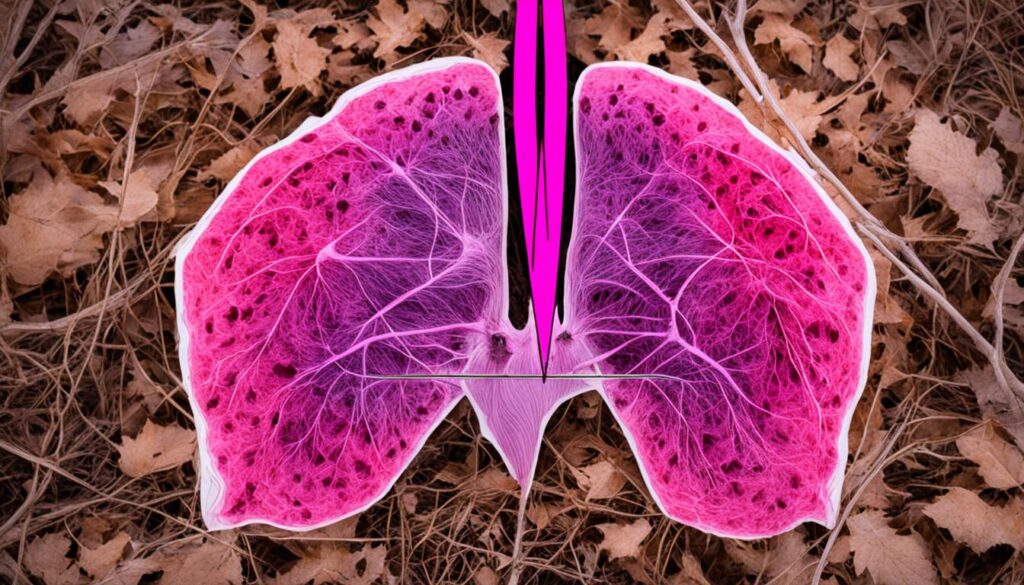
| Vital Organs | Location | Target Characteristics |
|---|---|---|
| Lungs | Behind the front shoulder | – Larger target – Higher margin of error |
| Heart | Partially covered by the lungs | – Smaller target – Higher precision required |
| Liver | Hidden behind the diaphragm | – Smaller target – More challenging to hit |
As shown in the table above, the lungs are easily accessible behind the front shoulder, providing a larger target area and a higher margin of error. This makes them the ideal kill zone for ethical hunters.
By focusing on effectively targeting the lungs, hunters can achieve quick and clean kills, ensuring a more responsible approach to hunting and conservation.
Deer Shot Placement Guide Based on Hunter Angles
The angle and distance between the hunter and the deer play a critical role in shot placement. Understanding the different angles and their implications can help hunters make informed decisions for successful and ethical kills.
Broadside Shot
The broadside shot occurs when the deer is perpendicular to the hunter. This angle provides the best opportunity to hit the vital organs, including the heart and lungs, with a broad target area. It offers a high chance of quick and effective kills.
Quartering-Away Shot
The quartering-away shot is when the deer’s body is angled away from the hunter. While not as ideal as the broadside shot, it still allows access to the heart and lungs. Hunters must aim behind the shoulder, towards the midsection of the deer, to achieve optimum shot placement and a clean kill.
“The broadside shot provides the best opportunity to hit the vital organs, while the quartering-away shot can still offer a good chance for an ethical kill.”
Quartering-Towards Shot
The quartering-towards shot presents a more challenging scenario. This angle carries a higher risk of hitting the front shoulder and guts instead of the vital organs. It is not recommended unless the hunter is experienced and confident in their accuracy. In such cases, one must aim towards the front part of the deer, just behind the shoulder, to avoid hitting non-vital areas.
To summarize, understanding the broadside, quartering-away, and quartering-towards shots is crucial for hunters to make accurate and ethical shot placements. The broadside shot offers the best opportunity to hit the vital organs, while caution must be exercised with the quartering-away and quartering-towards shots to avoid potential damage to non-vital areas.
| Shot Angle | Advantages | Considerations |
|---|---|---|
| Broadside Shot | Perpendicular position offers a broad target area to hit vital organs. | Optimal shot placement with higher chances of quick and humane kills. |
| Quartering-Away Shot | Access to the heart and lungs, allowing for an ethical kill. | Requires aiming behind the shoulder to hit vital organs accurately. |
| Quartering-Towards Shot | Challenging angle that requires precision and experience. | Higher risk of hitting non-vital areas such as the shoulder and guts. |
Other Shot Placements and Considerations
While the broadside and quartering-away shots are the preferred choices, it’s important for hunters to be aware of other shot placements and the associated considerations. These alternative shots may come with higher risks or may not be recommended for various reasons. Let’s take a closer look at each one:
Frontal Shot
The frontal shot involves targeting the deer head-on. However, this shot presents a small target, making it challenging to hit the vital organs accurately. It also carries the potential risk of obstructing bone and fatty tissue, further reducing the chance of an effective kill. Due to the difficulty and the potential for wounding rather than killing the deer, the frontal shot is generally not recommended.
Head/Neck Shot
The head/neck shot involves aiming at the deer’s head or neck region. While it may seem like a precise shot, it comes with significant risks. A misplaced head/neck shot can result in poor shot placement, causing unnecessary suffering for the animal and potential damage to the meat. This shot is not advisable for ethical and effective deer hunting.
Straightaway Shot
The straightaway shot occurs when the deer is moving directly away from the hunter. While it may seem like an open opportunity for a shot, it can lead to poor shot placement and reduced chances of a clean kill. In addition, hitting the deer in the hindquarters may result in minimal damage and the risk of a wounded animal. Therefore, the straightaway shot is not the preferred choice for ethical hunting.
Straight-Down Shot
The straight-down shot is only available when hunting from treestands. It involves aiming at a deer directly below the hunter. This shot presents a small and challenging target, requiring exceptional accuracy. While it may seem tempting, the straight-down shot should be approached with caution. Misplaced shots can result in wounded animals and unnecessary suffering. Consider the difficulty and the potential risks carefully before attempting a straight-down shot.
Understanding these considerations and the associated risks can help hunters make ethical decisions in the field. By prioritizing precise shot placement and choosing the optimal angles, hunters can contribute to the successful and responsible harvest of deer.
Deer Shot Placement Tips and Factors to Consider
When preparing to take a shot at a deer, it’s important to consider various factors that can affect shot placement. One vital factor is the deer’s head position. A deer with its head down is more likely to react quickly and drop lower to the ground upon hearing the shot. This natural reaction can significantly impact the trajectory of your shot, potentially resulting in a missed or ineffective shot. It’s crucial for hunters to be aware of the deer’s head position and adjust their aim accordingly to compensate for any movement.
In addition to head position, another factor that hunters must account for is the potential for string jump. String jump occurs when a deer reacts to the sound of a shot by instinctively dropping its body to avoid the perceived threat. This reaction can cause the shot to impact higher on the deer’s body than intended, potentially resulting in a non-lethal or non-ideal shot. To compensate for string jump, hunters should aim slightly lower than the desired target, taking into consideration the deer’s reaction time.
Understanding these natural reactions and compensating for movement is essential in achieving precise shot placement. By carefully observing the deer’s head position and anticipating the potential for string jump, hunters can make the necessary adjustments to ensure a clean and ethical kill. A successful shot not only requires technical skill and accuracy but also a deep understanding of the animal’s behavior and natural instincts.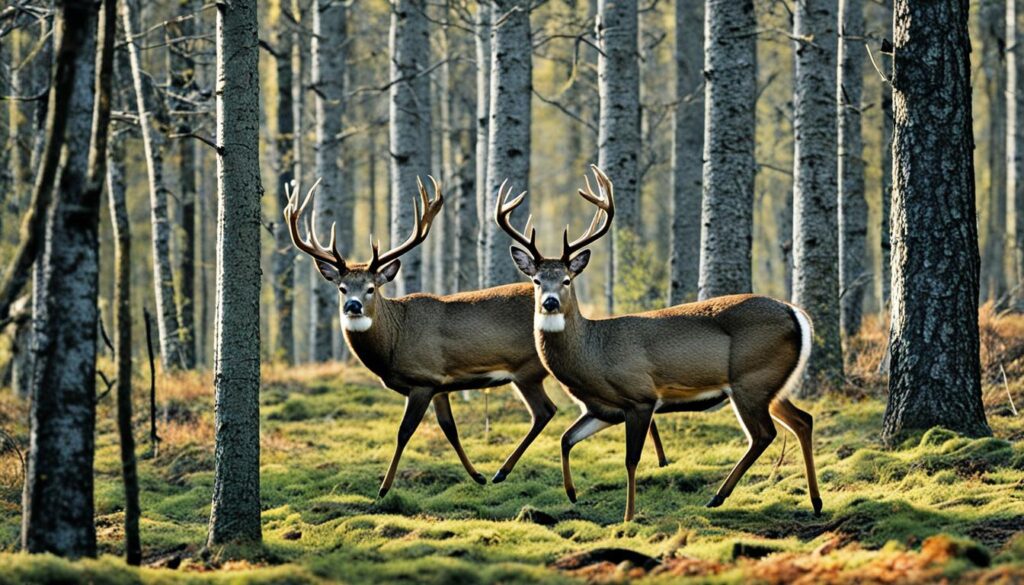
Remember, each hunting situation is unique, and it’s essential to assess the circumstances carefully. Taking the time to evaluate the deer’s head position, anticipate any potential reactions, and compensating for movement can significantly improve shot placement and increase the chances of a clean and ethical kill. By prioritizing precision and adapting to the deer’s behavior, hunters can contribute to responsible hunting practices and ensure humane harvests.
Conclusion
Mastering precise shot placement is the cornerstone of ethical hunting and ensuring a clean and humane kill. By understanding the anatomy of a deer and the vital organs involved, hunters can significantly increase their chances of success in the field while minimizing unnecessary suffering for the animal.
When aiming for a clean kill, hunters should prioritize targeting the heart and lungs. These vital organs provide the largest kill zone and offer a higher margin of error. By aiming for this area, hunters can achieve a quick and efficient takedown, leading to a clean harvest.
Remember, ethical hunting means making every shot count. By practicing precise shot placement and prioritizing clean kills, hunters can contribute to the responsible and sustainable management of deer populations. Let us embrace the importance of precision and ethical hunting practices for a more responsible future in the field.FAQ
What is the best shot placement for deer hunting success?
What should I know about deer anatomy?
Where should I aim for a quick and clean kill?
Are there any challenging shot placements on a deer?
What are the preferred angles for shot placement?
Are there any shot placements that are not recommended?
What factors should I consider for shot placement?
How important is precise shot placement in hunting?
Paul’s love for animals knows no bounds. As a dedicated writer and animal lover, Paul brings a unique perspective to our team. His firsthand experiences with various animals enrich our content and provide valuable insights into their behavior and needs. Whether he’s sharing tips for pet care or shedding light on pressing conservation issues, Paul’s passion for animals shines through in everything he does.
Deers
Understanding Deer Poop: Tracking & Garden Health
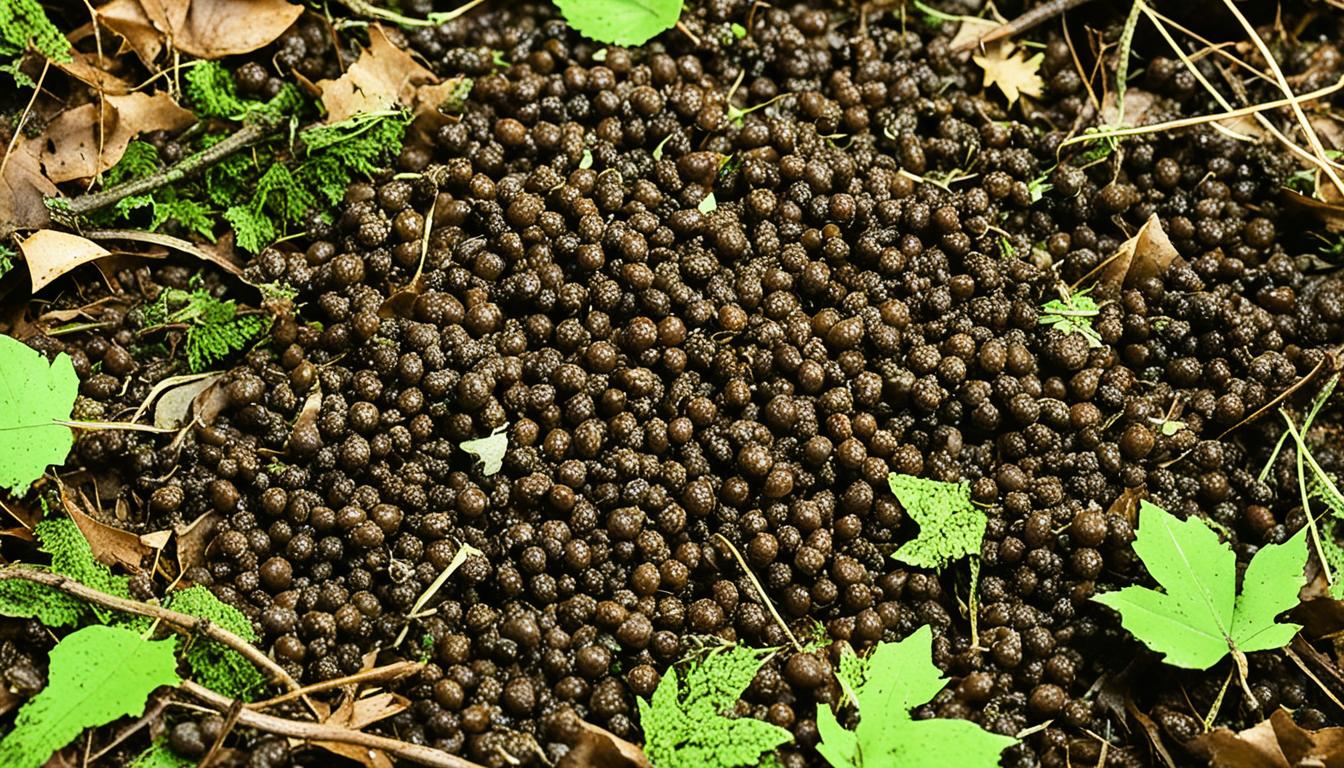
Did you know that deer excrement can offer valuable insights into the behavior of deer? It can reveal where they feed, rest, and move, making it a vital tool for both hunters and nature enthusiasts. Recognizing deer feces accurately is essential for tracking wildlife and evaluating garden wellness. In this article, we will discuss the key features of deer droppings, distinguish them from other animal waste, and grasp their importance in tracking deer and promoting a flourishing garden.
Key Takeaways:
- Deer poop can provide insights into deer behavior, such as feeding and traveling patterns.
- Identifying the main characteristics of deer scat is essential for tracking wildlife and assessing garden health.
- Deer poop can be differentiated from other animal droppings based on its appearance.
- It is not possible to determine the sex of a deer based on its droppings alone.
- Deer scat can be used as a natural fertilizer in gardens, but precautions should be taken.
Main Characteristics of Deer Poop
Deer poop has several main characteristics that can help identify it. It consists of brown, oval-shaped pellets that are typically between .2 to .5 inches in length. When fresh, deer scat has a shiny, wet appearance. Some pellets may be tapered on one end, while others may be perfectly round. The consistency of deer poop can range from moist to fibrous depending on the water content of their diet. There is typically no visible food in the pellets, giving them a uniform appearance. Moister scat may have clumps of pellets pressed together, while dryer scat will have a more scattered appearance.
Key Characteristics of Deer Poop:
- Brown, oval-shaped pellets
- Size between .2 to .5 inches
- Shiny, wet appearance when fresh
- Variation in shape, with some pellets tapered and others round
- Consistency ranging from moist to fibrous
- No visible food, uniform in appearance
- Moister scat may clump together, while dryer scat appears more scattered
Quote:
“Deer poop can provide valuable insights into the behavior of deer, making it essential to recognize its main characteristics.”
By understanding the main characteristics of deer poop, you can easily differentiate it from other animal droppings. This knowledge will enable hunters and wildlife enthusiasts to track deer movements accurately. Additionally, being able to identify deer poop can help gardeners assess deer activity on their property and take appropriate measures to protect their gardens.
Deer Poop Look-Alikes
When it comes to identifying deer poop, it’s essential to be able to differentiate it from other animal droppings. Here are some common look-alikes to be aware of:
Rabbit Scat
Rabbit scat is usually a pile of round, brown pellets. In comparison, deer pellets are more oval in shape.
Bear Scat
Bear scat is much larger and less-formed than deer scat. It often contains food remnants such as fruit pits, nut shells, or even human food or trash.
Elk Scat
Elk scat is similar in appearance to deer scat but larger in size. The size difference can help in accurately identifying deer scat.
Pronghorn Scat
Pronghorn scat may have a more irregular shape and can look like small chocolate chips.
By familiarizing yourself with the distinguishing characteristics of these look-alikes, you can confidently identify deer scat when you come across it.
Buck vs. Doe Poop
Contrary to popular belief, it’s not possible to determine the sex of a deer based on their droppings alone. There is no discernible way to tell what produced a particular scat, whether it was a male or female deer. The size of the droppings can vary among individuals, with larger animals generally producing larger piles of pellets. Bucks may leave behind an average of 70 to 80 pellets, while does may leave an average of 50 to 60. However, these size differences cannot definitively indicate the sex of the deer.
Whitetail Poop vs. Mule Deer Poop
Whitetail poop and mule deer poop can be challenging to differentiate based solely on appearance. However, the primary distinction lies in their diet, heavily influenced by their respective regions. Whitetail deer inhabiting the eastern United States feed on a variety of lush, temperate-climate forbs and browse. On the other hand, mule deer in the Western and Southwestern regions have adapted to a diet dominated by shrubs.
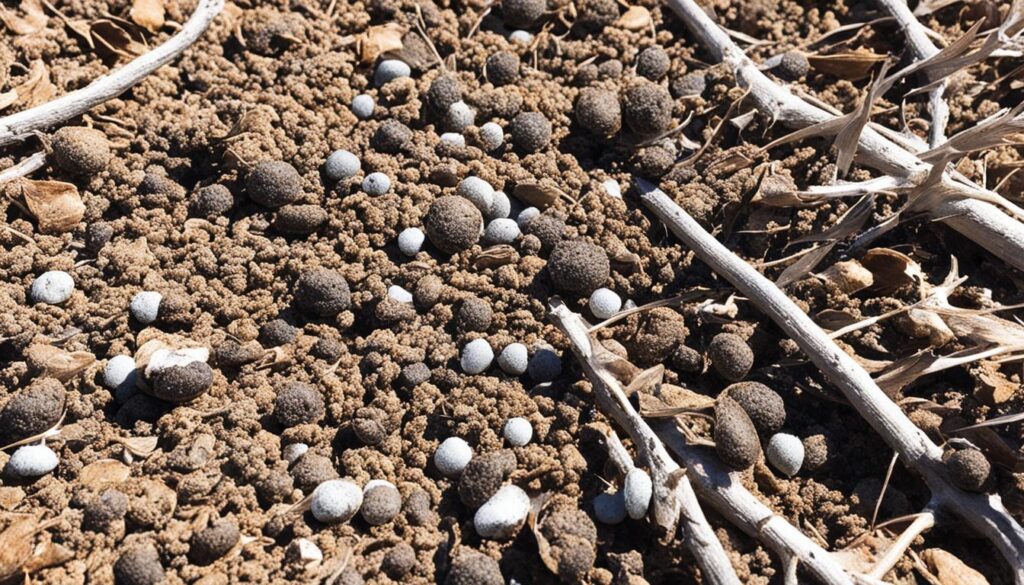
As a result of their dietary differences, mule deer scat tends to have lower moisture content and dries out more quickly in the arid climates of the West and Southwest. In regions where their ranges overlap, it becomes virtually impossible to differentiate between the scat of whitetail deer and mule deer.
The Importance of Deer Scat in Tracking and Gardening
Deer scat plays a vital role in tracking and understanding the behavior of deer. It holds valuable insights into their movements, feeding patterns, and favored resting places. Recognizing deer scat can be incredibly helpful for hunters, aiding them in identifying potential hunting spots and predicting deer movement. Additionally, deer scat serves as an essential indicator for gardeners, confirming the presence of deer on their property and allowing them to take necessary measures to protect their precious plants and flowers.
Moreover, deer scat is not only valuable to hunters and gardeners but also to scientists and researchers. It provides a wealth of information about herd health, hormone levels, and the presence of diseases like chronic wasting disease. Scientists study deer scat to understand the overall well-being of deer populations and make informed decisions for conservation efforts.
Understanding deer scat’s importance in tracking and gardening empowers individuals to make informed decisions in wildlife management and garden health. By learning to identify and analyze deer scat, enthusiasts can gain valuable insights into the lifestyle and habits of these majestic animals while simultaneously protecting their precious gardens.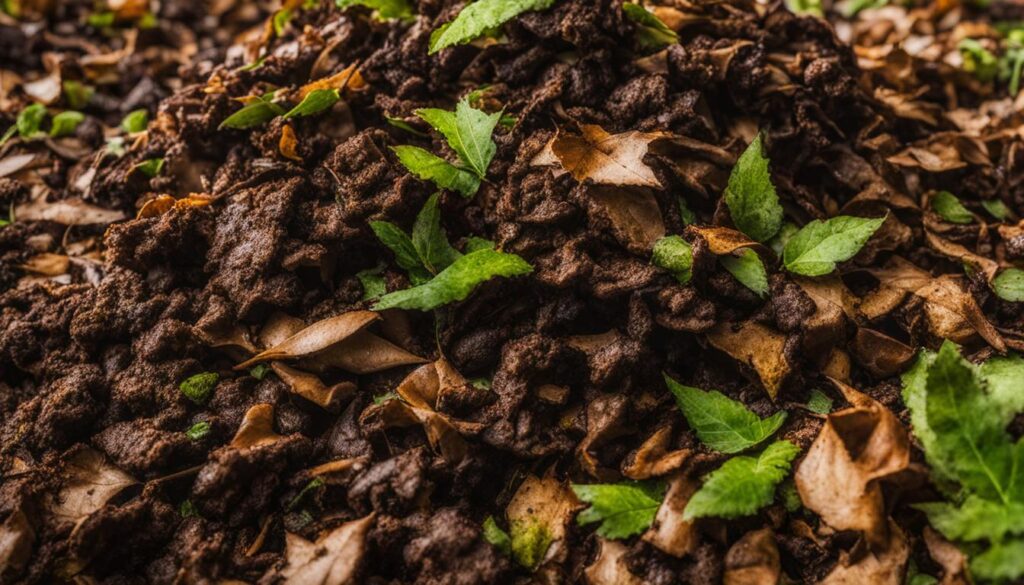
Deer Scat: A Closer Look
To fully appreciate the importance of deer scat, let’s take a closer look at its characteristics:
| Characteristics | Description |
|---|---|
| Shape | Oval-shaped pellets |
| Color | Dark brown |
| Size | Varies, but typically between .2 to .5 inches in length |
| Consistency | Moist to fibrous depending on the diet and water content |
By familiarizing yourself with these characteristics, you can easily distinguish deer scat from other animal droppings, ensuring accurate tracking and effective garden management.
Is Deer Poop Harmful?
Deer droppings are not typically harmful and are composed of plant matter that will break down over time. However, it’s important to exercise caution and avoid direct contact with deer droppings, especially if your yard is overrun with deer. While a few piles of deer droppings pose minimal risk to your backyard, pets, or gardens, it’s advisable to fence off your vegetable garden to avoid potential contamination. Always practice good hygiene when handling deer scat and wash your hands thoroughly afterwards.
Deer droppings, also known as deer scat, are a natural part of the environment and can be found in areas where deer frequently roam. They are typically small, dark-brown pellets that are easily recognizable. While deer poop is generally harmless, it’s important to take precautions to ensure garden safety and prevent any potential contamination. Here are some key points to consider:
Preventing Contamination
If deer frequently visit your garden, it’s a good idea to take measures to prevent contamination from their droppings. Fencing off your vegetable garden can help keep deer out and minimize the risk of them leaving droppings in the area where you grow your food. Additionally, practicing good hygiene when handling deer scat, such as wearing gloves and washing your hands thoroughly afterwards, can help reduce the risk of spreading any potential contaminants.
Garden Safety
Deer droppings are primarily composed of plant matter and will break down over time. However, if you have a large amount of deer poop in your garden, it can affect the overall health and safety of your plants. Deer poop contains high levels of nitrogen, which can be beneficial for plant growth when properly composted. However, if not properly managed, an excessive amount of deer droppings can lead to an imbalance in the nutrient levels and potentially harm your plants. It’s important to monitor the amount of deer scat in your garden and take appropriate action to maintain a healthy balance.
By taking precautions to prevent contamination and ensuring a balanced amount of deer poop in your garden, you can enjoy the presence of deer while promoting garden safety and maintaining a thriving garden.

| Animal | Appearance | Size | Composition |
|---|---|---|---|
| Deer | Small, dark-brown pellets | 0.2-0.5 inches in length | Primarily plant matter |
| Rabbit | Round, brown pellets | Varies | Primarily plant matter |
| Bear | Larger, less-formed | Varies | May contain food remnants |
| Elk | Similar to deer scat | Larger than deer scat | Primarily plant matter |
Where Do Deer Usually Poop?
Deer tend to have specific areas where they prefer to relieve themselves, which can provide valuable insights into their habits and whereabouts. Understanding their pooping habits can help you track their movements and optimize your hunting or gardening strategies accordingly.
- Bedding Areas: Deer typically defecate shortly after waking up, near their bedding areas. These areas are where deer rest and seek shelter, such as thickets, tall grasses, or wooded areas.
- Feeding Areas: You can often find piles of deer poop near their feeding areas. Deer are herbivores and feed on various vegetation, so look for their droppings in areas with abundant food sources like fields, meadows, or the edges of forests.
- Daily Roaming: Since deer poop throughout the day, you may come across their droppings almost anywhere they roam. They tend to leave their droppings as they move around their habitat, so keep an eye out for deer poop along trails, near water sources, or even in your own backyard if they frequent the area.
By identifying the locations where deer poop is concentrated, you can gain insights into their daily routines and preferred areas. This knowledge can be invaluable for hunters looking to track deer or for gardeners seeking to understand deer behavior and protect their gardens from deer browsing.
Note: Image above depicts deer poop, providing a visual reference for the topic of this section.
Can I Use Deer Poop in My Garden?
Yes, you can use small amounts of deer poop as a natural fertilizer in your garden. Deer droppings contain a high amount of nitrogen, which is a vital nutrient for plant growth. Nitrogen helps plants produce lush, green foliage and promotes healthy development.
However, before using deer poop as fertilizer, it’s crucial to ensure that the manure has aged properly to avoid potential bacterial contamination. Fresh deer scat may contain harmful pathogens that can pose a risk to human health. It’s recommended to allow the manure to decompose for at least 90 to 120 days before using it in your garden.
The aging process allows any bacteria present in the manure to break down, making it safe for use as a fertilizer. Once properly aged, deer poop can be an excellent eco-friendly option to enhance the health and productivity of your garden.
When applying deer poop, it’s best to spread it evenly over the soil surface and then water it in. The nutrients from the manure will slowly release into the soil, providing a steady supply of nutrition to your plants. Remember to avoid over-fertilizing, as excessive nitrogen content can harm plants.
Benefits of Using Deer Poop as Fertilizer:
- Rich in nitrogen: Deer droppings are packed with nitrogen, a crucial nutrient for plant growth.
- Slow-release: Deer poop releases nutrients gradually, providing a steady supply for your plants.
- Eco-friendly: Using deer poop as fertilizer is a natural and sustainable way to enhance garden health.
- Cost-effective: Instead of purchasing commercial fertilizers, deer poop can be a free and readily available option.
By incorporating deer poop into your garden routine, you can improve soil fertility, promote healthy plant growth, and reduce the need for synthetic fertilizers.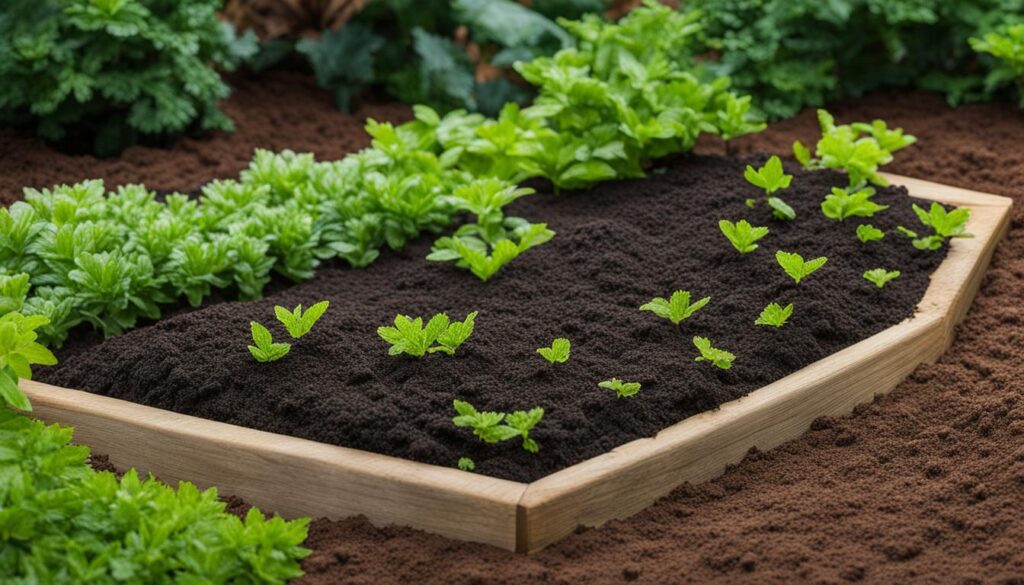
Remember to always practice proper hygiene when handling deer droppings or any other type of organic fertilizer. After handling the manure, wash your hands thoroughly to prevent the spread of bacteria.
Conclusion
Deer poop, also known as deer scat, offers valuable insights into the behavior of these majestic creatures. By understanding the main characteristics of deer poop and being able to differentiate it from other animal droppings, hunters and wildlife enthusiasts can track the movements and patterns of deer. Whether it’s determining where deer feed, bed down, or travel, the presence of deer scat provides important clues.
Moreover, deer scat plays a significant role in assessing the health of your garden. The presence of deer poop can confirm the presence of deer on your property, allowing you to take necessary measures to safeguard your garden. Additionally, scientists rely on deer scat to study herd health, hormone levels, and the presence of diseases like chronic wasting disease.
Understanding the significance of deer poop in tracking wildlife and assessing garden health is essential. By honing your identification skills and recognizing the distinguishing characteristics of deer scat, you can gain a deeper appreciation and knowledge of these magnificent creatures. So, the next time you come across deer poop, remember the valuable insights it offers into the world of deer and the role it plays in tracking wildlife and promoting garden health.FAQ
What are the main characteristics of deer poop?
How can I differentiate deer poop from other animal droppings?
Can deer poop indicate the sex of the deer?
How can I differentiate between whitetail poop and mule deer poop?
What is the importance of deer scat in tracking and gardening?
Is deer poop harmful?
Where do deer usually poop?
Can I use deer poop as fertilizer in my garden?
Paul’s love for animals knows no bounds. As a dedicated writer and animal lover, Paul brings a unique perspective to our team. His firsthand experiences with various animals enrich our content and provide valuable insights into their behavior and needs. Whether he’s sharing tips for pet care or shedding light on pressing conservation issues, Paul’s passion for animals shines through in everything he does.
Deers
Understanding Deer Anatomy: An Overview

Hunting is an exciting and rewarding experience that involves expertise and understanding. Have you ever considered how knowing deer anatomy can greatly improve your hunting success? Recognizing the key organs of a deer and where to aim for a humane and ethical kill can help hunters achieve a swift and efficient harvest.
Knowing the anatomy of a deer, including the heart, lungs, stomach, liver, and intestines, is essential for making ethical shots. By aiming for the right target, hunters can minimize suffering and make quick recoveries. In this article, we will explore the different shot placements and provide valuable insights into where to shoot a deer for a clean and ethical kill.
Key Takeaways:
- Understanding deer anatomy is crucial for ethical hunting.
- Knowing the vital organs helps hunters make clean and effective shots.
- Shot placement plays a significant role in minimizing suffering and ensuring a quick recovery.
- Different shot placements are suitable for various angles and situations.
- Respecting and understanding the anatomy of deer improves hunting skills and promotes ethical practices.
The Heart Shot
A heart shot on a deer is lethal and can result in a quick kill. However, it may not always provide the best blood trails. When a bullet or broadhead penetrates the heart, it often also pierces the lungs, which helps ensure a quicker recovery of the animal. A well-placed heart shot requires a sufficient caliber bullet to penetrate the shoulder blade. It’s important to consider the potential loss of meat when using larger bullets.
When aiming for a heart shot, hunters need to be mindful of the deer’s anatomy. The heart is located in the chest cavity, nestled behind the shoulder blade. It is a vital organ responsible for pumping oxygenated blood to the rest of the body. A well-placed shot that targets the heart can immediately incapacitate the deer, leading to a clean and ethical kill.
A heart shot, when executed properly, can deliver a quick and humane kill. It is essential for hunters to have a good understanding of deer anatomy and shot placement to ensure they hit the heart with precision.
However, it is important to note that a heart shot may not always provide the best blood trails. Since the bullet or broadhead may also pierce the lungs, blood trails can be less pronounced compared to other shot placements. This can make tracking the deer more challenging, especially in dense vegetation.
The Lung Shot
The lungs provide a large target for both rifle hunters and bowhunters. A bullet or broadhead that enters the lungs will make it difficult for the deer to breathe, often resulting in a quick kill. However, incomplete pass-through shots or clipping the lungs may lead to poor blood trails and a more difficult-to-track animal. It’s crucial to aim for the middle of the lung area for an effective lung shot.
When executing a lung shot, hunters should have a clear understanding of deer anatomy. The lungs are located in the chest cavity, just behind the shoulder blades. Take into account the specific placement in relation to the deer’s body size and angle of the shot.
A rifle or broadhead with ample penetration capabilities is essential for a lung shot. It’s important to select the appropriate ammunition or broadhead for the chosen weapon. Rifles with a high muzzle velocity and sufficient power are ideal for achieving a clean lung shot. For bowhunters, a broadhead with good cutting diameter and sharpness will increase the chances of a successful lung shot.
By aiming for the middle of the lung area, hunters can increase the likelihood of hitting the vital organs while avoiding clipping the lungs. This will result in a quick kill and minimize the risk of a wounded deer fleeing to a hard-to-find location.
Remember, even with a precise lung shot, it’s crucial to track the deer after the shot to ensure a successful recovery. Watch for signs of a clean hit, such as a hunched posture, short-run distance, or visible blood trails. These indicators will aid in locating the deer and completing the harvest.
Benefits of a Lung Shot
A lung shot offers several advantages for both rifle hunters and bowhunters. Here are some key benefits:
- The lungs present a large target area, increasing the chances of a successful shot.
- When the lungs are damaged, the deer’s ability to breathe is compromised, leading to a quick kill.
- If the shot is precise and the bullet or broadhead fully penetrates, the deer will leave a clear blood trail, making tracking and recovery easier.
- A lung shot typically results in minimal meat loss compared to other shot placements.
Keep in mind that shot placement is crucial and can vary depending on the deer’s position and angle. It’s essential to practice ethical hunting and make every effort to ensure a clean and humane kill for the benefit of both the hunter and the deer.
| Lung Shot | Advantages |
|---|---|
| Large target area | Increases chances of success |
| Disrupts deer’s ability to breathe | Results in a quick kill |
| Potential for clear blood trails | Eases tracking and recovery |
| Minimal meat loss | Compared to other shot placements |

The Neck Shot
A neck shot is a controversial shot placement that aims to sever the arteries in the neck of a deer. If executed correctly, it can be a lethal and bloody shot that causes minimal damage to the meat. However, this shot is not without its risks and ethical considerations.
Understanding deer anatomy is crucial when considering a neck shot. The neck contains vital structures such as arteries, veins, and the spinal cord. If the shot severs the arteries, it can result in rapid blood loss and a quick kill. However, if the spine is not severed, the deer may still be able to escape or become difficult to recover.
It’s important to note that taking a neck shot with a gun is risky and not recommended for most hunters. The small target area and the potential for missing or hitting non-lethal areas increase the risk of wounding rather than cleanly killing the animal. Bowhunters should also avoid neck shots due to the difficulty of making an accurate and lethal shot.
“A neck shot should only be attempted by experienced hunters who have a thorough understanding of deer anatomy and are confident in their marksmanship skills,” advises renowned hunter and author, Mark Johnson.
When considering shot placement, hunters should prioritize the most ethical and effective methods to ensure a clean and humane kill. While a neck shot may seem like an attractive option for preserving meat, the potential risks and uncertainties associated with this shot make it less favorable compared to other shot placements.
Remember, taking an ethical shot and having a deep understanding of deer anatomy are the foundations of responsible and humane hunting.
Comparison of Shot Placements
| Shot Placement | Advantages | Disadvantages |
|---|---|---|
| Heart Shot | Quick kill | Potential loss of meat |
| Lung Shot | Large target area, difficulty breathing | Poor blood trails if incomplete pass-through shots |
| Neck Shot | Lethal, minimal meat damage | Risk of non-lethal shots, difficult recovery |
| Brain Shot | Immediate drop, no meat loss | Difficult shot, potential for unnecessary suffering |

The Brain Shot
A brain shot is a highly effective method of taking down a deer with precision and immediate results. However, it is considered one of the most difficult shots to execute due to the small target area.
When aiming for a brain shot, the objective is to hit the deer’s brain, instantly incapacitating the animal. This shot ensures a clean and ethical kill, leaving no room for suffering. However, accuracy is paramount, as a misplaced shot can cause unnecessary harm and make it challenging to recover the deer.
The brain shot offers a significant advantage in terms of meat preservation. Unlike shots that might affect vital organs or muscle tissue, the brain shot causes no loss of meat.
Making a brain shot requires a steady hand, keen eye, and thorough knowledge of deer anatomy. It is crucial to understand the precise location of the brain within the deer’s skull to maximize the chances of a successful shot.
“Aiming for a brain shot requires skill and precision. It may be a difficult shot to master, but it guarantees a quick and humane kill for the deer.” – Expert Hunter
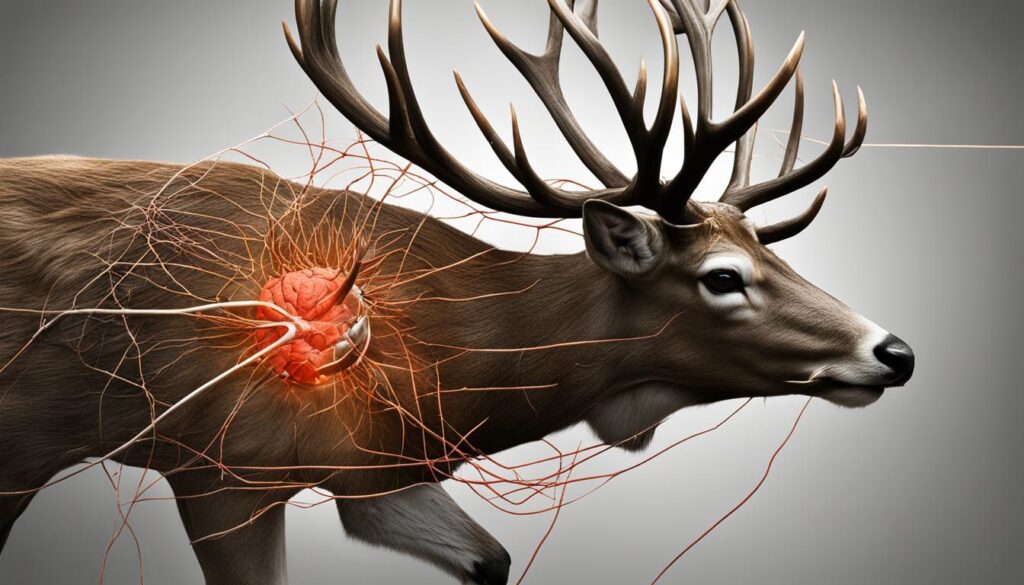
Deer Digestive System
Deer have a four-chamber stomach that plays a crucial role in their digestion process. Each chamber serves a specific purpose in breaking down their food and extracting nutrients.
The first chamber is the rumen, where food is swallowed and partially broken down by digestive bacteria. This chamber acts as a fermentation vat, allowing bacteria to break down cellulose and other tough plant materials that deer consume in their diet.
After spending some time in the rumen, the partially digested food is regurgitated and chewed again. This process, known as “chewing the cud,” allows deer to further break down the food and improve digestion.
The regurgitated food then moves into the next chamber, called the reticulum. The reticulum acts as a strainer, separating larger indigestible particles from the smaller digestible ones.
From the reticulum, the smaller particles pass into the omasum. The omasum is responsible for absorbing water from the food, ensuring the deer stays hydrated even when water sources are limited.
Finally, the food enters the last chamber, called the abomasum. The abomasum is comparable to the stomach in humans and other animals, producing acid to further break down the food and releasing digestive enzymes to extract nutrients. Once the food is broken down, it passes into the intestines for further absorption and elimination.
Understanding the different chambers of the deer’s digestive system helps us appreciate the incredible adaptability of these animals to their plant-based diet. It also highlights the importance of providing deer with a varied and nutritionally-rich diet in the wild.
Deer Legs
Despite their thin appearance, deer legs possess remarkable speed and power. While they cannot maintain top speed for long distances, deer can run up to 40 miles per hour in short bursts. The hind legs provide the power for their speed and jumping ability. Deer also have tarsal glands on the inside of their hind legs, which secrete a musky scent used for communication during the breeding season.
Deer legs are a marvel of nature, enabling these graceful creatures to navigate their environment with agility and grace. Despite their lightweight and slender appearance, deer possess an incredible burst of speed and power, allowing them to outrun potential threats and cover vast distances when necessary.
The hind legs, in particular, play a crucial role in powering the deer’s locomotion. These muscular limbs propel the animal forward with explosive force, enabling them to reach impressive speeds. While they cannot sustain their top speed for long durations, deer can sprint up to 40 miles per hour in short bursts, evading predators and finding safety in a matter of seconds.
In addition to their speed, deer legs also contribute to their remarkable jumping ability. The combination of their powerful hind legs and flexible joints enables them to effortlessly leap over obstacles, such as fallen logs or fences, with grace and ease.
It is worth mentioning that deer possess tarsal glands on the inside of their hind legs, which serve an additional purpose beyond locomotion. These glands secrete a musky scent that is used for communication during the breeding season. This scent is detectable by other deer and plays a crucial role in mating rituals and interactions.
Antlers
Male deer have impressive antlers on their heads, which are composed of live tissue made of bone. Antlers have the fastest tissue growth rate of any animal, and they undergo a remarkable transformation throughout the year. During the spring, whitetail antlers can grow at an average rate of up to two inches per week.
During the growth phase, antlers are covered in a soft, velvet-like substance. This velvet supplies vital nutrients and blood flow to support the rapid growth of the antler. As the antlers mature, the velvet begins to dry and peel.
Once autumn arrives, antler growth comes to a halt, and bucks shed their antlers between January and March. The shedding process is facilitated by specialized cells that dissolve the attachment between the antlers and the deer’s head. Shed antlers pave the way for the growth of new ones during the following year.

Male deer use their antlers for various purposes, including display, dominance battles, and attracting mates during the rutting season.
Whitetail Ears and Hearing
Whitetail deer have very sensitive hearing, which plays a critical role in their survival. The muscles attached to their ears allow them to rotate and hear in multiple directions without moving their heads. This keen sense of hearing helps them detect potential dangers, such as human presence or predator sounds. 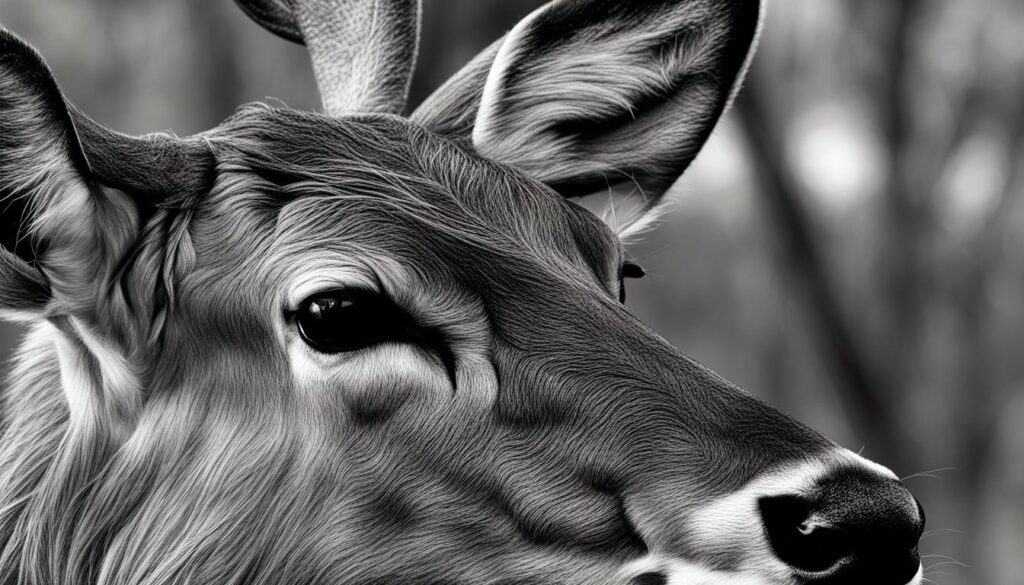
Eyesight
Deer have a strong sense of eyesight, surpassing human vision in certain aspects. They rely on their eyesight, along with their sense of smell and hearing, to detect and react to potential threats. While not as acute as their hearing, their eyesight helps them identify movement and objects in their surroundings.
Eyesight: Key Points
- Deer possess strong eyesight, which complements their other senses in threat detection.
- Their vision allows them to identify movement and objects in their surroundings.
- While they cannot discern colors as vividly as humans, they have excellent night vision.
- Deer’s eyes are located on the sides of their head, providing a wide field of view.
- They have a reflective layer behind their retinas, called the tapetum lucidum, which enhances their ability to see in low light conditions.
Eyesight: Exploring Deer’s Vision
Deer have adapted to their environment with eyes designed for survival. While their color vision is limited compared to humans, their visual acuity excels in low light conditions. Their eyes are positioned more towards the sides of their heads, allowing them to have a wide field of view and detect movement from different angles. This positioning is particularly advantageous for prey animals, helping them spot potential predators. Additionally, deer have a reflective layer behind their retinas, called the tapetum lucidum, which enhances their night vision by reflecting light back through the retina for a second chance at capturing an image.
Deer rely on their eyesight to detect and react to potential threats in their environment.
Comparing Deer’s Vision with Humans
While deer have superior night vision and the ability to detect movement more effectively than humans, their visual capabilities fall behind when it comes to color perception. Deer’s eyes contain fewer color-detecting cells, giving them limited color vision. The lack of precise color discrimination allows deer to blend in with their surroundings, enhancing their camouflage and evasive abilities. With their keen eyesight, deer can spot predators or humans at a distance, making it crucial for hunters to remain concealed and minimize their movements.
| Aspect | Deer Vision | Human Vision |
|---|---|---|
| Color Perception | Limited color vision | Vivid color perception |
| Low Light Vision | Excellent night vision | Relatively poor night vision |
| Field of View | Wide field of view (roughly 270 degrees) | Narrower field of view (roughly 180 degrees) |
| Depth Perception | Good depth perception | Superior depth perception |
Shot Placement Guide
Understanding shot placement is essential for ethical hunting and ensuring the recovery of a downed animal. Different angles and situations may require specific shot placement considerations. Broadside shots offer the best target area for hitting vital organs, whereas quartering-away shots require aiming further back. Frontal shots and head/neck shots are not recommended due to the risk of obstructing bones and limited target areas.
| Shot Placement | Description |
|---|---|
| Broadside Shot | Aim behind the shoulder to target the heart and lungs, ensuring a quick and humane kill. This shot provides the biggest target area. |
| Quartering-Away Shot | Aim further back towards the liver and other vital organs to account for the angle of the deer. This shot placement allows for a lethal hit even if the bullet or arrow doesn’t fully penetrate the body. |
| Frontal Shot | Not recommended due to the thick bones and limited target area. The risk of wounding the deer without causing a quick kill is high. |
| Head/Neck Shot | Also not recommended due to the risk of obstructing bones and limited target area. These shots should only be attempted by highly skilled marksmen. |
Remember, ethical hunting involves making clean kills and ensuring the animal’s welfare. Proper shot placement based on deer anatomy is crucial for achieving this goal.
Conclusion
Understanding deer anatomy is paramount for ethical hunting and ensuring quick and humane kills. Hunters must have a comprehensive knowledge of the deer’s vital organs, such as the heart and lungs, to achieve the most effective shot placement.
In addition to understanding deer anatomy, hunters should also familiarize themselves with other aspects of the animal’s physiology. Knowing about the deer’s digestive system, legs, antlers, ears, and eyesight can contribute to becoming a well-rounded and knowledgeable hunter.
By respecting and understanding the anatomy of these majestic creatures, hunters can strive for clean and ethical kills. This not only ensures a quick and humane death for the deer but also reduces the risk of a wounded animal suffering unnecessarily.FAQ
What is the best shot placement for a deer?
How can I achieve a quick kill with a heart shot?
Are lung shots effective in killing a deer?
Is a neck shot recommended for hunting deer?
How effective is a brain shot in killing a deer?
What are the different chambers of a deer’s stomach?
How fast can a deer run?
How do deer use their antlers?
How sensitive is a deer’s hearing?
How good is a deer’s eyesight?
What should I know about shot placement for ethical hunting?
Why is understanding deer anatomy important for hunting?
Paul’s love for animals knows no bounds. As a dedicated writer and animal lover, Paul brings a unique perspective to our team. His firsthand experiences with various animals enrich our content and provide valuable insights into their behavior and needs. Whether he’s sharing tips for pet care or shedding light on pressing conservation issues, Paul’s passion for animals shines through in everything he does.
Deers
Optimize Wildlife Watching with Deer Feeders

Are you aware that utilizing deer feeders can significantly improve your wildlife observation experience and attract more deer to your surroundings?
Whether you’re a photographer looking to capture stunning images of deer in their natural habitat or simply a wildlife enthusiast wanting to observe these majestic creatures up close, deer feeders can be a game-changer.
By strategically placing deer feeders and using the right feed, you can create a haven for deer, increasing the likelihood of sightings and creating memorable wildlife viewing opportunities.
Let’s explore the world of deer feeders and discover how to optimize your wildlife watching adventures.
Understanding Deer Feeders
Deer feeders play a crucial role in attracting deer for wildlife observation and photography. There are several types of deer feeders available, each with its own advantages and features. Understanding these different types, including gravity feeders, hanging feeders, and automatic feeders, can help individuals select the right feeder for their specific needs.
Gravity Feeders
Gravity feeders rely on the force of gravity to dispense feed. They feature a large hopper that holds a significant amount of feed, which gradually falls into a tray or trough as deer consume the feed. Gravity feeders can be easily refilled and require minimal maintenance, making them a popular choice among wildlife enthusiasts.
Hanging Feeders
Hanging feeders, as the name suggests, are suspended from a tree or structure. They typically feature a container or bag that holds the feed, which is accessed by deer as they stand beneath the feeder. Hanging feeders offer the advantage of adjustability, allowing users to control the height and placement of the feeder to attract deer to specific areas.
Automatic Feeders
Automatic feeders are equipped with timers that dispense feed at predetermined intervals. These feeders can be programmed to release feed at specific times of the day, ensuring a consistent food source for deer. Automatic feeders are ideal for individuals who may not be able to visit the feeding site regularly, as they provide a reliable and automated feeding solution.
“Deer feeders come in different types, including gravity feeders, hanging feeders, and automatic feeders, offering unique benefits and features.”
Choosing the Right Deer Feeder
When it comes to selecting a deer feeder, several factors need to be considered to ensure optimal performance and successful wildlife viewing. The feeder’s capacity, location, and materials play vital roles in attracting deer and maintaining the feeder’s durability.
Feeder Capacity
The feeder’s capacity directly determines how much feed it can hold at one time. The appropriate feeder capacity depends on factors such as the frequency of visits, the number of deer, and the accessibility of the hunting grounds. A larger capacity may be preferred for areas with fewer human interventions and longer intervals between refills, while a smaller capacity may be sufficient for higher-traffic locations.
Feeder Location
The feeder’s location is key to attracting deer and ensuring their safety. It should be strategically placed in an accessible and visible spot, where deer are known to frequent. Placing the feeder near natural cover, such as trees or shrubs, can provide additional security for the deer and make them more comfortable approaching the feeder. Hunters must also consider their safety and convenience when choosing the feeder location.
Feeder Materials
The materials of the feeder significantly impact its durability and weather resistance. Opting for feeders made from sturdy and weather-resistant materials, such as metal or high-quality plastic, can ensure a longer lifespan and protect the feed from moisture, pests, and other environmental factors. Additionally, if the feeder is placed in an area prone to extreme weather conditions, it’s essential to select materials that can withstand those challenges.
By carefully considering the feeder capacity, location, and materials, hunters and wildlife enthusiasts can make informed decisions and choose a deer feeder that suits their specific needs. This, in turn, increases the chances of attracting deer to the feeding area and enhances the overall wildlife-watching experience.
Key Features of Deer Feeders
Deer feeders come with a range of key features that enhance their functionality and convenience. These features include programmable digital timers, varmint guards, long battery life, and adjustable flow settings. Let’s take a closer look at each of these features and how they contribute to optimizing your wildlife watching experience.
Programmable Digital Timers
One of the key features of deer feeders is the inclusion of programmable digital timers. These timers allow users to set specific feeding times and intervals, ensuring a consistent and controlled food dispersion. By programming the feeder to release feed at certain times, you can attract deer to your desired location when they are most active, increasing the chances of successful wildlife viewing. This feature provides convenience and flexibility, allowing you to customize your feeding schedule according to your observations and preferences.
Varmint Guards
Unwanted animals, such as raccoons and squirrels, can pose a threat to your deer feeder and its contents. To address this concern, many deer feeders come equipped with varmint guards. These guards act as barriers, preventing unauthorized access to the feeder. By effectively deterring pests and critters, varmint guards ensure that the feed remains secure and accessible only to the target wildlife, enhancing the effectiveness of your feeder.
Battery Life
Deer feeders often rely on battery power to operate their timers and dispensing mechanisms. Therefore, it is essential to consider the battery life when choosing a feeder. Long battery life ensures uninterrupted operation, reducing the need for frequent battery replacements and minimizing potential disruptions to your wildlife observation routine. Some feeders also offer the option of solar panel attachments, which provide a sustainable and eco-friendly power source, further extending the battery life.
Adjustable Flow Settings
To cater to varying feeding preferences and environmental conditions, many deer feeders come with adjustable flow settings. These settings allow you to control the rate and amount of feed dispensed by the feeder. By adjusting the flow, you can ensure a consistent and optimal food supply, promoting regular visits from deer and other wildlife. This feature enables you to adapt to changing seasons, population dynamics, and specific feeding requirements in different habitats, enhancing the effectiveness of your feeder.
In summary, deer feeders offer a range of key features that optimize wildlife watching. Programmable digital timers allow for customized feeding schedules, varmint guards protect against unwanted animals, long battery life ensures uninterrupted operation, and adjustable flow settings provide control over feed dispersion. By selecting a deer feeder with these features, you can enhance your wildlife viewing experience and increase the chances of observing deer in their natural habitat.

Best Deer Feeders for Hunting in 2023
For hunters looking for a reliable deer feeder with a digital timer, the Moultrie 30-Gallon Deer Feeder Tripod is the perfect choice. This top pick for 2023 offers a range of features that enhance hunting efficiency and convenience.
The Moultrie 30-Gallon Deer Feeder Tripod is equipped with a programmable digital timer, allowing users to set up to four feed times per day. This feature provides precise control over feeding schedules, optimizing the chances of attracting deer to desired hunting areas.
The feeder also boasts a durable metal spin plate, ensuring even feed distribution for efficient and effective feeding. This feature eliminates the risk of uneven feeding patterns that might deter deer from approaching the feeder.
Additionally, the Moultrie 30-Gallon Deer Feeder Tripod features quick-lock technology, enabling hunters to easily set up and take down the feeder. This convenience saves time and effort, allowing hunters to focus on other essential aspects of their hunting strategy.
With its sturdy construction and advanced features, the Moultrie 30-Gallon Deer Feeder Tripod offers hunters a reliable and efficient tool for attracting deer to their desired hunting areas. Its digital timer, metal spin plate, and quick-lock technology make it an excellent choice for hunters seeking a high-quality and user-friendly deer feeder.
Expert Tips for Feeder Strategies and Tips
To optimize the effectiveness of your deer feeders, it’s important to implement strategic strategies and practices. Here are some expert tips on feeder location, power needs, and maintenance to enhance your wildlife viewing experience.
Feeder Location
When determining the ideal placement for your deer feeder, consider high traffic areas where deer are likely to roam. Look for spots near bedding areas, trails, or food sources to attract deer. It’s also important to ensure the feeder is easily accessible for maintenance and refilling. Additionally, consider placing the feeder in a secluded area away from human activity to minimize disturbance and increase the chances of deer visiting.
Power Needs
Choosing the right power source for your deer feeder is crucial for ensuring its consistent operation. If the hunting ground receives ample sunlight, opt for a solar-powered feeder. Solar power eliminates the need for frequent battery replacements and ensures a reliable energy source. However, in heavily wooded areas with limited sunlight, high-quality batteries are the best choice. Select batteries with a longer amp hour rating to extend their lifespan and consider marking the starting date to keep track of their usage and anticipate replacements.
Maintenance
Regular maintenance is key to keeping your deer feeder in optimal condition. Routine checks and cleanings of feeder parts, such as timers, motors, and spinner plates, help prevent malfunctions and ensure consistent feed dispersal. Additionally, consider implementing varmint-proof measures, such as using locking mechanisms or critter guards, to ward off unwanted visitors and protect your feeder’s contents. Selecting the right type of feed, free from moisture and debris, is also essential for preventing clogs and maximizing the feeder’s performance. To facilitate smooth feed flow, consider using a funnel attachment, especially if it’s not included with the feeder unit.
Expert Tip: “Regular maintenance and strategic feeder placement are key to attracting deer and maximizing your wildlife viewing opportunities.” – John Davis, Wildlife Biologist
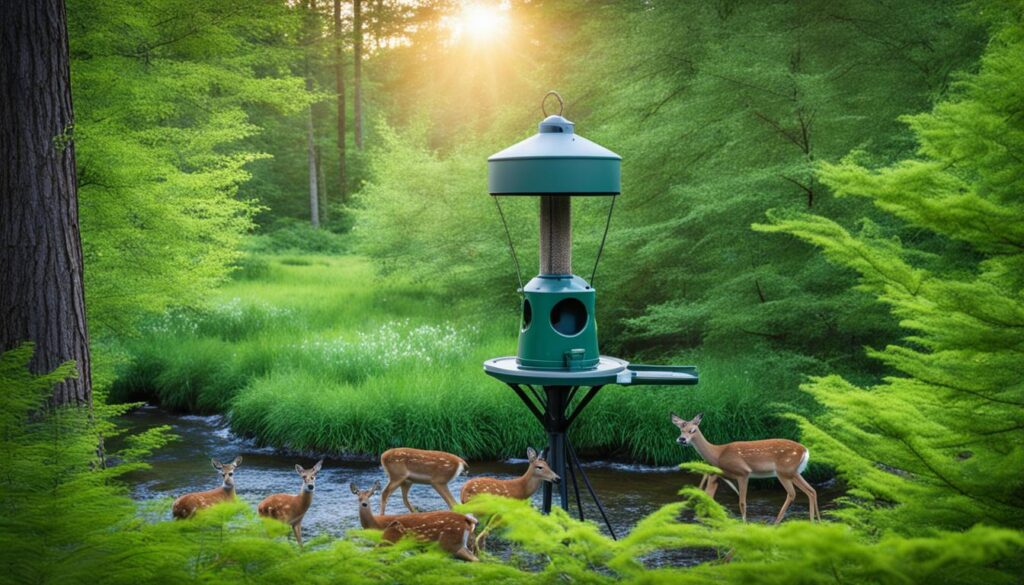
Implementing these expert tips for feeder strategies, including optimal feeder location, power source selection, and regular maintenance, will elevate your wildlife watching endeavors. By attracting deer with a well-placed and well-maintained feeder, you’ll increase your chances of observing these majestic creatures in their natural habitat.
Importance of Feeder Size
The size of the feeder is an important factor to consider when selecting a deer feeder. Bigger feeders are recommended for hunters who live further away from their hunting grounds and require larger feed capacities. Smaller feeders can be used for localized hunting spots and to encourage deer movement in challenging terrain. The location of the feeder should also be taken into account, with flat terrain being the most suitable.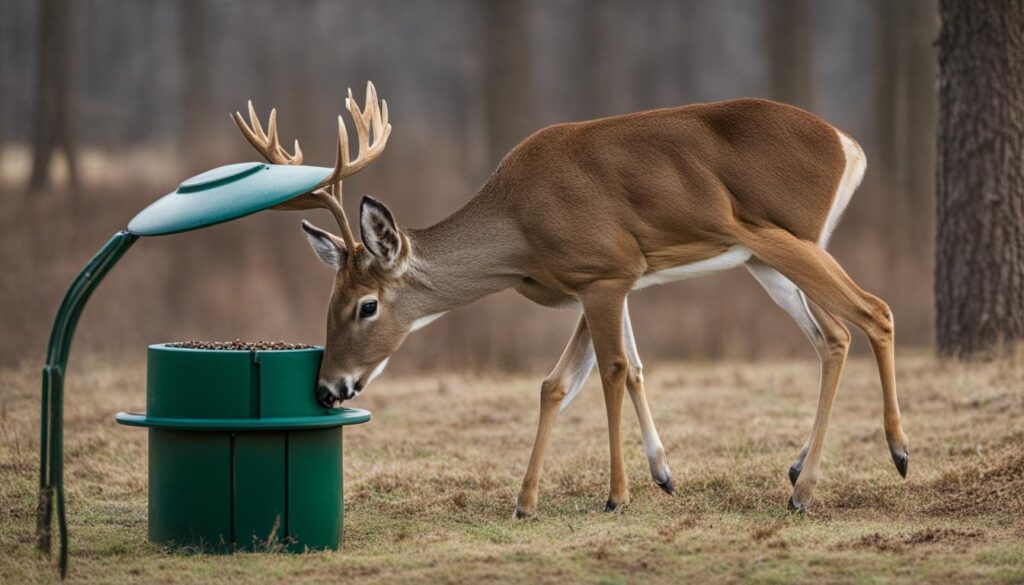
| Feeder Size | Advantages |
|---|---|
| Bigger Feeders |
|
| Smaller Feeders |
|
Powering the Feeder
To ensure optimal performance of a deer feeder, choosing the right power source is crucial. Depending on the location and specific requirements, various options are available, including solar-powered feeders and high-quality batteries. Both options offer distinct advantages, with considerations for battery selection and battery life.
Solar-Powered Feeders
Solar-powered deer feeders are an excellent choice for those who prefer an eco-friendly and hands-off approach. These feeders utilize solar panels to convert sunlight into energy, charging the internal battery for continuous operation. However, it’s important to note that heavily wooded areas or low light conditions can limit the effectiveness of solar-powered feeders.

Battery Selection
For areas with limited sunlight or when solar-powered feeders are not suitable, using high-quality batteries is essential. Opting for batteries with a longer amp hour rating ensures extended battery life and reduces the frequency of replacements. It is recommended to choose renowned brands known for their reliable performance and durability.
Battery Life
Monitoring the battery life of a deer feeder is important to ensure uninterrupted feeding. One simple way to keep track of battery usage is by marking the starting date when the battery is installed. Regularly checking the battery charge level will help determine when replacements are needed, avoiding unexpected disruptions in feed dispensing.
Maintaining the Feeder
Regular maintenance is crucial for keeping deer feeders in optimal condition. Taking proactive steps to address potential issues and ensure smooth feeder operation can enhance your wildlife viewing experience. Here are some essential maintenance tasks to consider:
Carry Spare Parts
It’s always a good idea to carry spare batteries, timers, motors, and spinner plates when using a deer feeder. Having these spare parts on hand allows for quick replacements in case of any malfunction, minimizing disruptions to the feeding schedule.
Check and Clean Feeder Parts
Regularly inspect and clean the various parts of your feeder to prevent clogging, damage, or malfunction. Pay close attention to the spinner plate, feed chute, and hopper area. Remove any debris, moisture, or mold that may have accumulated to maintain smooth feed flow and ensure feed quality.
Utilize Varmint-Proof Measures
Varmints such as raccoons, squirrels, and birds can damage or disrupt your deer feeder. Implementing varmint-proof measures, such as using wire mesh guards or baffle plates, can help deter these unwanted visitors. Regularly check and reinforce these measures to ensure their effectiveness.
Ensure Feed Quality
The quality of the feed you provide to the deer is essential for their health and attraction. Regularly inspect the feed to ensure it is free from moisture, mold, and debris. Opt for high-quality deer feed that meets nutritional requirements and avoids aflatoxin contamination, which can be harmful to deer.
Maintaining your deer feeder not only ensures its longevity but also contributes to a successful wildlife watching experience. By taking the time to perform regular maintenance tasks and address any issues promptly, you can attract more deer and enjoy observing them in their natural habitat.
“Regular maintenance is crucial for keeping deer feeders in optimal condition.”
Using the Right Feed
Choosing the right feed is crucial for ensuring the proper function of deer feeders. While corn is a commonly used feed for deer, it’s important to prioritize the quality of the feed to maintain the health and well-being of the animals. Aflatoxin, a harmful toxin produced by certain molds, can contaminate corn and pose a serious risk to deer if consumed. Therefore, it is vital to select aflatoxin-free feed to provide a safe and nourishing diet.
Adding other attractants or protein pellets to the feed may seem like a good idea, but it can lead to clogging issues within the feeder. These additional substances may not flow smoothly through the feeder mechanism, causing disruptions in the feed distribution process. To ensure the proper functioning of the feeder and prevent these complications, it is advisable to stick to a single feed type, such as clean and aflatoxin-free corn.
In order to keep the feed in optimal condition, it is recommended to use a galvanized lid and a funnel. The galvanized lid helps prevent moisture-related issues, such as mold growth and feed spoilage, while ensuring the feed remains dry and fresh. Additionally, a funnel can be used to facilitate the smooth flow of feed from the feeder spout, minimizing the risk of clogs and blockages.
By carefully selecting the feed, avoiding additives that may cause clogs, and implementing appropriate preventative measures, individuals can optimize the functionality of their deer feeders and provide the deer with a safe and reliable source of nourishment.

| Feed Selection Guidelines | Pros | Cons |
|---|---|---|
| Aflatoxin-Free Corn | Safe and nourishing for deer | May be more expensive |
| Other Attractants | Potentially entices deer | Can cause clogging in the feeder |
| Protein Pellets | Supplemental source of nutrients | Potential for clogs and blockages |
The Importance of Funnel Placement
The use of funnels is highly recommended for deer feeders as they serve an essential role in ensuring smooth and consistent feed dispersion. Funnels provide gravity assistance, allowing feed to flow seamlessly from the feeder spout to the feeding area. Their proper placement plays a crucial role in preventing clogs and optimizing the feeder’s performance.
When using a deer feeder, the feeder funnel acts as a conduit that directs the feed from the storage container to the feeding area. Without a funnel, the feed may not flow smoothly due to the awkward angle of the feeder spout, leading to potential clogs and disruptions in feed distribution. By incorporating a funnel, the feed is guided down a desired path, ensuring a consistent and controlled flow.
Funnels can be purchased separately if they are not included with the feeder unit. It’s important to choose a funnel that matches the specifications of the feeder to ensure a proper fit. Additionally, some feeders come with adjustable funnels, allowing users to customize the feed dispersion and optimize the feeding process.
By incorporating a funnel into the deer feeder setup, users can prevent clogs and ensure that the feed reaches the desired feeding area effectively. This gravity-assisted flow not only enhances the overall functionality of the feeder but also attracts deer to the designated feeding spot, enhancing wildlife observation opportunities.
| Benefits of Funnel Placement in Deer Feeders |
|---|
| Prevents clogs in the feeder spout |
| Ensures a smooth and consistent flow of feed |
| Guides feed directly to the desired feeding area |
| Enhances the performance and functionality of the feeder |
When positioning the funnel, it’s crucial to consider the angle and alignment to achieve the desired feed flow. Placing the funnel at the correct angle ensures that the feed flows naturally and consistently, while also preventing any potential blockages. It’s recommended to position the funnel slightly inclined and directly under the feeder spout, allowing the feed to slide smoothly into the feeding area.
Overall, the proper placement of funnels in deer feeders is a vital factor to consider for optimal feeder performance. By leveraging the gravity assistance provided by the funnel, users can prevent clogs, ensure consistent feed dispersion, and attract deer to the designated feeding area, enhancing the wildlife watching experience.
Conclusion
Optimizing wildlife watching with deer feeders is a key strategy for successful wildlife viewing. By implementing strategic feeder placement, selecting the right power source, maintaining the feeder regularly, and using the appropriate feed, individuals can enhance their wildlife viewing experience and increase the chances of observing deer in their natural habitat.
Following expert tips and guidelines is essential in the journey of deer feeder optimization. Placing the feeder in high traffic areas, ensuring accessibility and seclusion, and considering the power needs are vital factors to consider. Regular maintenance, such as checking and cleaning feeder parts and implementing varmint-proof measures, ensures smooth feeder operation.
Choosing the right feed, such as aflatoxin-free corn, and utilizing funnel placement can prevent clogs and enhance feed flow. A successfully optimized deer feeder attracts deer and provides an opportunity for individuals to witness these majestic creatures up close.FAQ
What are the different types of deer feeders?
How do gravity feeders work?
How are hanging feeders different from other types?
What are the advantages of automatic feeders?
What factors should I consider when selecting a deer feeder?
What key features should I look for in a deer feeder?
Which deer feeder is recommended for hunting in 2023?
How can I optimize the effectiveness of my deer feeder?
What size of deer feeder should I choose?
How should I power my deer feeder?
What maintenance is required for deer feeders?
What type of feed should I use for my deer feeder?
Why is funnel placement important for deer feeders?
Paul’s love for animals knows no bounds. As a dedicated writer and animal lover, Paul brings a unique perspective to our team. His firsthand experiences with various animals enrich our content and provide valuable insights into their behavior and needs. Whether he’s sharing tips for pet care or shedding light on pressing conservation issues, Paul’s passion for animals shines through in everything he does.
-

 Vetted1 month ago
Vetted1 month ago15 Best Dog Food Brands Recommended by Vets for Healthy and Happy Pups
-

 Vetted1 month ago
Vetted1 month ago14 Best Homemade Dog Food Recipes Your Pup Will Love – Vet Approved & Nutritious
-

 Vetted1 month ago
Vetted1 month ago15 Best Cat Foods for Managing Hyperthyroidism – Vet Approved and Feline Friendly
-

 Vetted3 weeks ago
Vetted3 weeks ago15 Best Dog Foods for Kidney Disease – Expert Recommendations for Your Pet's Health
-

 Vetted2 weeks ago
Vetted2 weeks ago15 Best Affordable Cat Foods That Won't Break the Bank
-

 Deers1 month ago
Deers1 month agoCaring for Baby Deer: Tips for Healthy Fawns
-

 Cats6 days ago
Cats6 days agoCat Weight Chart by Age: Kitten to Senior in Lbs
-

 Vetted1 month ago
Vetted1 month ago15 Best Kibble Dog Foods for a Healthy and Happy Pup



















